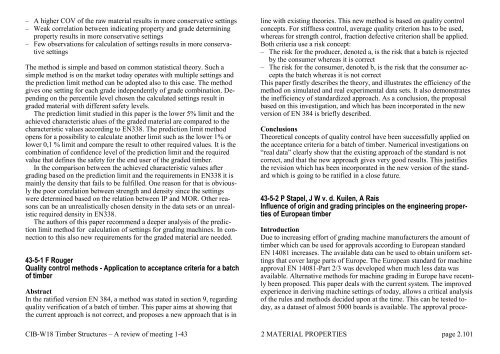CIB-W18 Timber Structures – A review of meeting 1-43 2 MATERIAL ...
CIB-W18 Timber Structures – A review of meeting 1-43 2 MATERIAL ...
CIB-W18 Timber Structures – A review of meeting 1-43 2 MATERIAL ...
- TAGS
- timber
- structures
- cib-w18.com
You also want an ePaper? Increase the reach of your titles
YUMPU automatically turns print PDFs into web optimized ePapers that Google loves.
<strong>–</strong> A higher COV <strong>of</strong> the raw material results in more conservative settings<br />
<strong>–</strong> Weak correlation between indicating property and grade determining<br />
property results in more conservative settings<br />
<strong>–</strong> Few observations for calculation <strong>of</strong> settings results in more conservative<br />
settings<br />
The method is simple and based on common statistical theory. Such a<br />
simple method is on the market today operates with multiple settings and<br />
the prediction limit method can be adopted also to this case. The method<br />
gives one setting for each grade independently <strong>of</strong> grade combination. Depending<br />
on the percentile level chosen the calculated settings result in<br />
graded material with different safety levels.<br />
The prediction limit studied in this paper is the lower 5% limit and the<br />
achieved characteristic alues <strong>of</strong> the graded material are compared to the<br />
characteristic values according to EN338. The prediction limit method<br />
opens for a possibility to calculate another limit such as the lower 1% or<br />
lower 0,1 % limit and compare the result to other required values. It is the<br />
combination <strong>of</strong> confidence level <strong>of</strong> the prediction limit and the required<br />
value that defines the safety for the end user <strong>of</strong> the graded timber.<br />
In the comparison between the achieved characteristic values after<br />
grading based on the prediction limit and the requirements in EN338 it is<br />
mainly the density that fails to be fulfilled. One reason for that is obviously<br />
the poor correlation between strength and density since the settings<br />
were determined based on the relation between IP and MOR. Other reasons<br />
can be an unrealistically chosen density in the data sets or an unrealistic<br />
required density in EN338.<br />
The authors <strong>of</strong> this paper recommend a deeper analysis <strong>of</strong> the prediction<br />
limit method for calculation <strong>of</strong> settings for grading machines. In connection<br />
to this also new requirements for the graded material are needed.<br />
<strong>43</strong>-5-1 F Rouger<br />
Quality control methods - Application to acceptance criteria for a batch<br />
<strong>of</strong> timber<br />
Abstract<br />
In the ratified version EN 384, a method was stated in section 9, regarding<br />
quality verification <strong>of</strong> a batch <strong>of</strong> timber. This paper aims at showing that<br />
the current approach is not correct, and proposes a new approach that is in<br />
line with existing theories. This new method is based on quality control<br />
concepts. For stiffness control, average quality criterion has to be used,<br />
whereas for strength control, fraction defective criterion shall be applied.<br />
Both criteria use a risk concept:<br />
<strong>–</strong> The risk for the producer, denoted a, is the risk that a batch is rejected<br />
by the consumer whereas it is correct<br />
<strong>–</strong> The risk for the consumer, denoted b, is the risk that the consumer accepts<br />
the batch whereas it is not correct<br />
This paper firstly describes the theory, and illustrates the efficiency <strong>of</strong> the<br />
method on simulated and real experimental data sets. It also demonstrates<br />
the inefficiency <strong>of</strong> standardized approach. As a conclusion, the proposal<br />
based on this investigation, and which has been incorporated in the new<br />
version <strong>of</strong> EN 384 is briefly described.<br />
Conclusions<br />
Theoretical concepts <strong>of</strong> quality control have been successfully applied on<br />
the acceptance criteria for a batch <strong>of</strong> timber. Numerical investigations on<br />
“real data” clearly show that the existing approach <strong>of</strong> the standard is not<br />
correct, and that the new approach gives very good results. This justifies<br />
the revision which has been incorporated in the new version <strong>of</strong> the standard<br />
which is going to be ratified in a close future.<br />
<strong>43</strong>-5-2 P Stapel, J W v. d. Kuilen, A Rais<br />
Influence <strong>of</strong> origin and grading principles on the engineering properties<br />
<strong>of</strong> European timber<br />
Introduction<br />
Due to increasing effort <strong>of</strong> grading machine manufacturers the amount <strong>of</strong><br />
timber which can be used for approvals according to European standard<br />
EN 14081 increases. The available data can be used to obtain uniform settings<br />
that cover large parts <strong>of</strong> Europe. The European standard for machine<br />
approval EN 14081-Part 2/3 was developed when much less data was<br />
available. Alternative methods for machine grading in Europe have recently<br />
been proposed. This paper deals with the current system. The improved<br />
experience in deriving machine settings <strong>of</strong> today, allows a critical analysis<br />
<strong>of</strong> the rules and methods decided upon at the time. This can be tested today,<br />
as a dataset <strong>of</strong> almost 5000 boards is available. The approval proce-<br />
<strong>CIB</strong>-<strong>W18</strong> <strong>Timber</strong> <strong>Structures</strong> <strong>–</strong> A <strong>review</strong> <strong>of</strong> <strong>meeting</strong> 1-<strong>43</strong> 2 <strong>MATERIAL</strong> PROPERTIES page 2.101














